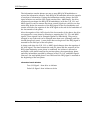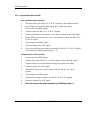
SCSI Description
3-22 Quantum DLT 7000 Tape System
Initiator-to-Drive Transfer Procedure
Initiator transfers one byte for each REQ pulse received.
1. Drive asserts the REQ signal.
2. After receiving the leading edge of the REQ signal, initiator drives the DB
(0-15, P, & P1) signals to their desired values. The DB (0-15, P, & P1)
signals are held valid for at least one deskew delay plus one cable skew delay
plus one hold time delay after the assertion of the ACK signal.
3. Initiator delays at least one deskew delay plus a cable skew delay.
4. Initiator asserts the ACK signal for a minimum of one assertion period.
5. Initiator can negate the ACK signal and change or release the DB (0-15, P,
& P1) signals.
6. Drive reads the DB (0-15, P, & P1) signals within one hold time of the
transition of the ACK signal to true.
7. The drive waits at least the greater of these periods before again asserting
the REQ signal:
a) A transfer period from the last transition of the REQ signal to true, or
b) A negation period from the last transition of the REQ signal to false.
8. The initiator waits at least the greater of the following periods before again
asserting the ACK signal:
a) A transfer period from the last transition of the ACK signal to true, or
b) A negation period from the last transition of the ACK signal to false.
3.5.5.3 Signal Restrictions Between Phases
When the SCSI bus is between two information transfer phases, the following
restrictions apply to the SCSI bus signals:
• The BSY, SEL, REQ, and ACK signals do not change.
• The C/D, I/O, MSG, and DATA BUS signals can change.
• When changing the DATA BUS direction from out (initiator-driving) to in
(drive-driving), the drive delays driving the DATA BUS by at least a data
release delay plus one bus settle delay after asserting the I/O signal. The
initiator releases the DATA BUS no later than a data release delay after the
transition of the I/O signal to true.


















